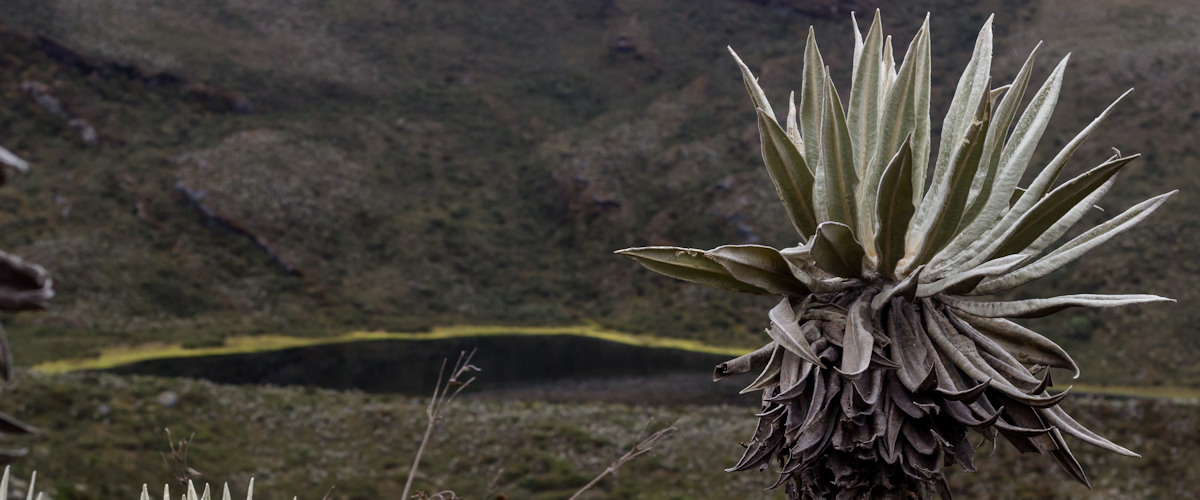
Integrating ecological and cultural histories to inform sustainable and equitable futures for the Colombian páramos
Primary Investigators: Professor Piran White, Dr Joshua Kirshner, Dr Julia Touza, Dr Adrián Villaseñor-Lopez (Department of Environment and Geography, University of York); Professor Henrice Altink, Dr Sabine Clarke, Dr Hanne Cottyn, Dr Helen Cowie (Department of History, University of York); Dr Colin Beale, Professor Jane Hill, Dr Chris Wheatley (Department of Biology, University of York)
External Collaborators: University of Cambridge, Universidad del Rosario, Universidad de los Andes, Humboldt Institute, The Nature Conservancy (Colombia), Royal Botanic Garden Edinburgh
Funder: NERC and AHRC (Newton-Caldas Fund Colombia Bio programme)
Project Duration: July 2018 - March 2022
Watch this short overview of the project presented by Primary Investigator Professor Piran White
In common with many upland systems throughout the world, the Andean páramos are under increasing pressure from social, climate and land use changes. The history of the páramo is fundamental in understanding these pressures and identifying possible solutions. For the Muisca people and for many páramo inhabitants today, páramos are sacred places from where the gods came that controlled water and the origin and maintenance of life. To European colonists, páramos were seen as the source of abundant mineral riches. More recently, the critical importance of páramos in providing fresh water to the growing urban populations of Colombia and supporting unique biodiversity have come to the fore. These competing pressures are placing increasingly diverse demands on the system, and, despite a number of initiatives both nationally and internationally, tensions over the management and governance of the system persist.
Our project investigated how an integrated environmental-historical understanding of páramo ecosystem patterns, processes and pressures can provide insights to new governance solutions. We took a 500-year historical perspective to analyse changes in the socio-ecological system of páramos over time, focusing on the central role of human-nature interactions and how these have changed in response to differing social, political and cultural contexts, over time periods from decades to centuries. We considered how these changes have impacted on ecosystem dynamics, and predicted what further changes are likely to occur in the future under climate and other drivers of change. We explored how human-nature relationships in páramo landscapes have changed and compared the perspectives of local communities with other private and state actors. We identified the potential for páramo communities to obtain monetary values from páramos and the ecosystem services they provide, examining the synergies and trade-offs between different ecosystem services.
Our research provides a unique historical context for the development of future governance options, including new partnerships between different stakeholders underpinned by greater social and cultural understanding. The project delivers recommendations for mechanisms to promote more sustainable and equitable futures for páramo landscapes, in the context of key political and social challenges such as post-conflict displacement, illegal mining, changing climate and increasing water demand from urbanisation.
Key Findings
| 1 | The impacts of future climate change across more than 130 species of páramo birds, mammals and plants (including 38 endemic species), will be much greater than those of land-use change. Moreover, more than 30 bird species not currently considered as being of conservation concern are at risk from future climate change. Conservation of páramo biodiversity should focus on locations where climate is projected to remain suitable and the risk of land-use change is low. |
| 2 | Private conservation initiatives such as reservas naturales de la sociedad civil (Private Nature Reserves; PNRs) have a significant impact on land use, but they have limited effectiveness in protecting or enhancing the paramo. Above 3,000m, PNRs have increased tree cover by 2% but reduced paramo cover by 2%. The role of private conservation initiatives in delivering conservation gains for the paramo could be enhanced through greater conditionality in terms of their intended outcomes and/or management actions. |
| 3 | Over the last 200 years, different visions of the paramo have jostled for power – the paramos as agrarian frontier, the paramos as water factory, and most recently the paramos as a strategic ecosystem. These different visions have caused conflict between different stakeholders – human and non-human – and have tended to sideline local knowledge and practices of the páramo. Local knowledge needs to become more visible and brought into dialogue with other forms of knowledge to develop ways to conserve the paramos while meeting the needs of all stakeholders. |
Project Outcomes
The Paramunos interactive platform provides a co-created space to share content on educational, research, and cultural practices aimed at caring for the páramo near the city of Bogotá, Colombia. Watch the English translation of platform launch
Overview of the project presented by Primary Investigator Professor Piran White
Other outcomes of the project include a children's book, the CD “Sonidos Agroecológicos” and documentary “Cantares del Páramo” showcasing páramo music, and several festivals of art and culture.
